Liquidation of Australian Firms: Ethical & Regulatory Analysis
VerifiedAdded on 2023/06/06
|12
|3045
|188
Report
AI Summary
This report provides an overview of the liquidation events of three Australian companies: ABC Learning, HIH Insurance, and OneTel Phone Company. It examines the reasons behind their financial collapses, including the impact of the global financial crisis, under-provisioning of expenses, and inefficient management. The report also discusses the APES 110 Code of Ethics for Professional Accountants, highlighting the principles of integrity, objectivity, professional competence, confidentiality, and professional behavior. Furthermore, it outlines key ASX listing rules related to continuous disclosure, periodic disclosure, capital changes, transactions with influential persons, significant transactions, ongoing requirements, document submission, and trading halts. The analysis concludes by addressing the liability issues faced by these companies, emphasizing their inability to meet debt obligations and maintain sufficient liquidity.
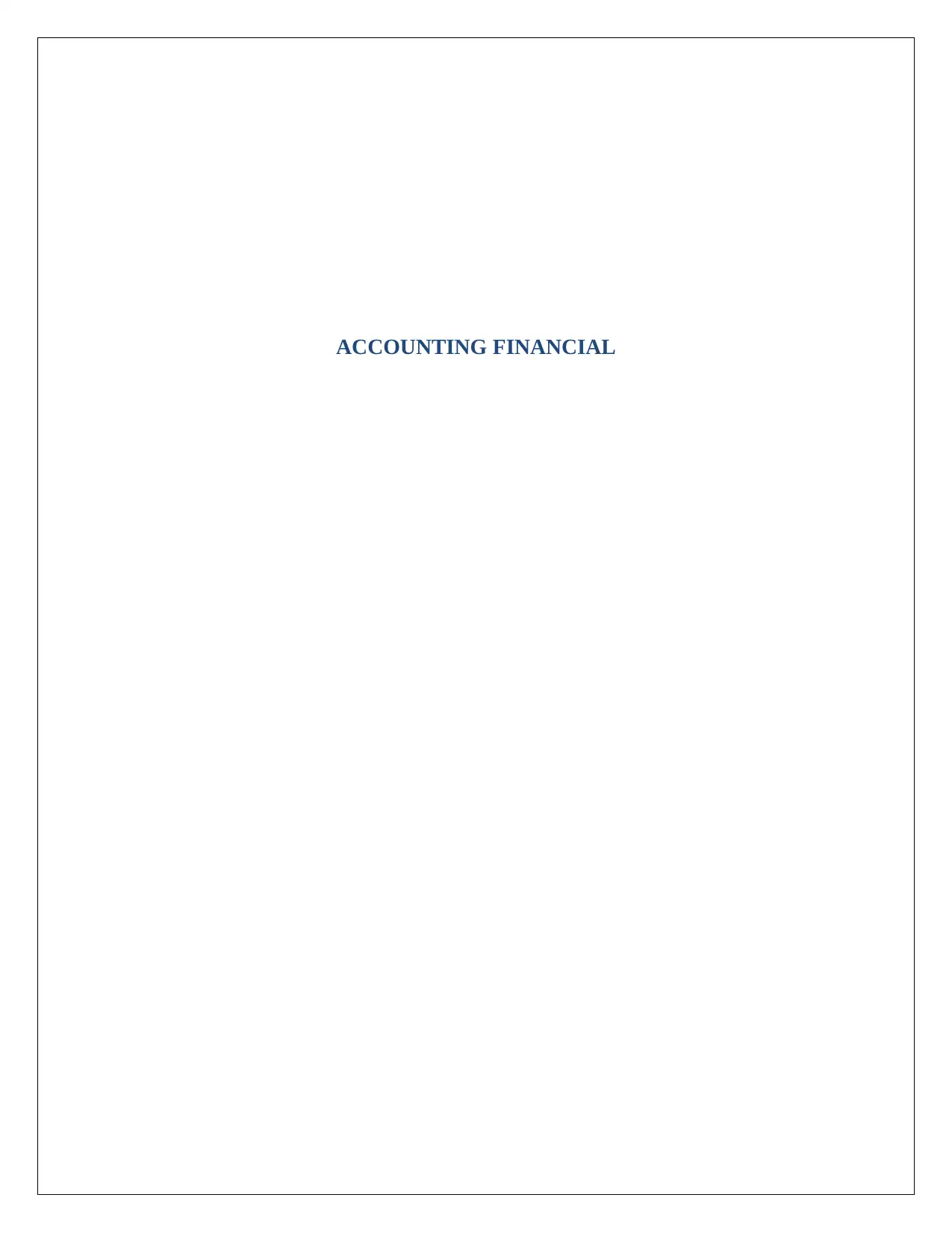
ACCOUNTING FINANCIAL
Secure Best Marks with AI Grader
Need help grading? Try our AI Grader for instant feedback on your assignments.
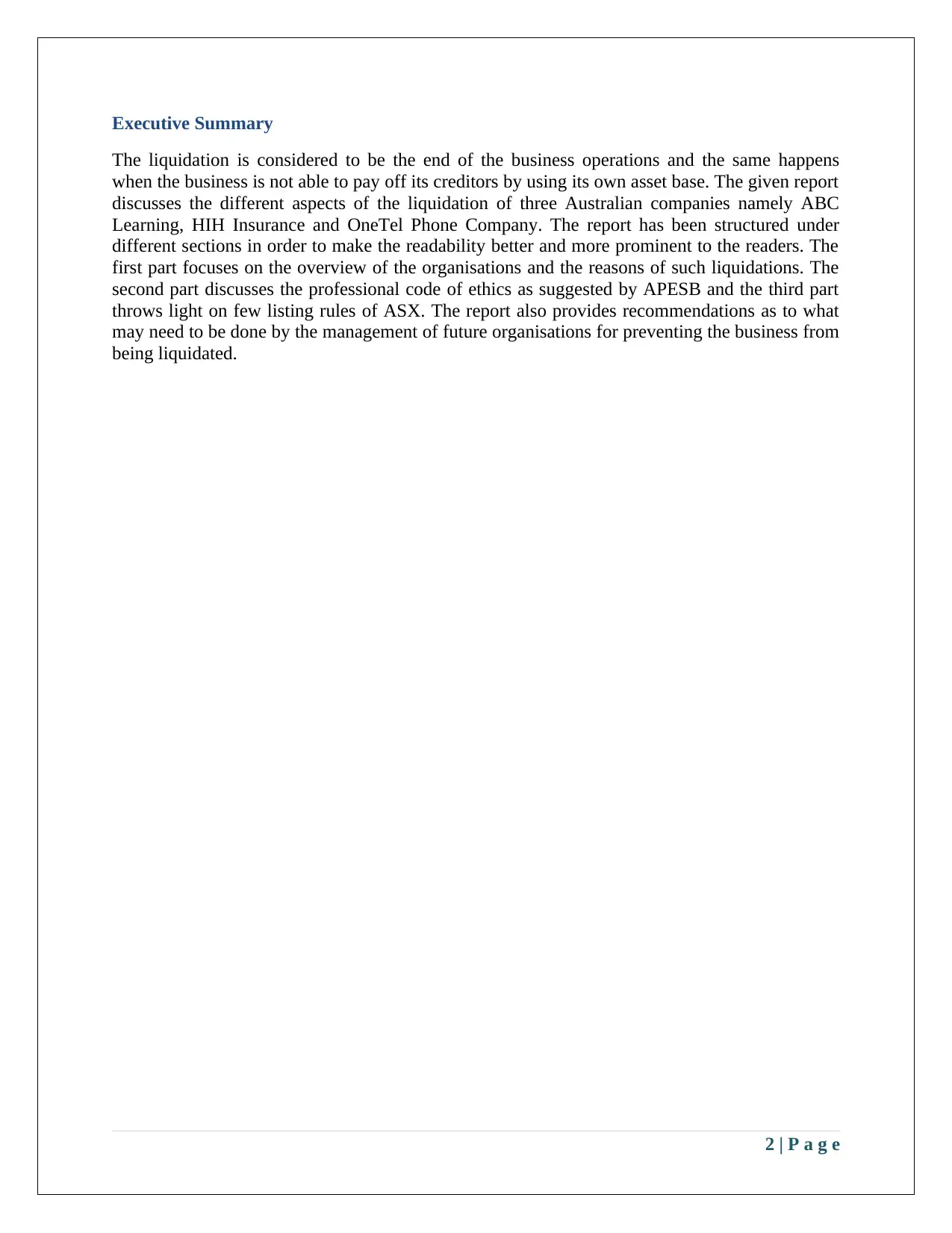
Executive Summary
The liquidation is considered to be the end of the business operations and the same happens
when the business is not able to pay off its creditors by using its own asset base. The given report
discusses the different aspects of the liquidation of three Australian companies namely ABC
Learning, HIH Insurance and OneTel Phone Company. The report has been structured under
different sections in order to make the readability better and more prominent to the readers. The
first part focuses on the overview of the organisations and the reasons of such liquidations. The
second part discusses the professional code of ethics as suggested by APESB and the third part
throws light on few listing rules of ASX. The report also provides recommendations as to what
may need to be done by the management of future organisations for preventing the business from
being liquidated.
2 | P a g e
The liquidation is considered to be the end of the business operations and the same happens
when the business is not able to pay off its creditors by using its own asset base. The given report
discusses the different aspects of the liquidation of three Australian companies namely ABC
Learning, HIH Insurance and OneTel Phone Company. The report has been structured under
different sections in order to make the readability better and more prominent to the readers. The
first part focuses on the overview of the organisations and the reasons of such liquidations. The
second part discusses the professional code of ethics as suggested by APESB and the third part
throws light on few listing rules of ASX. The report also provides recommendations as to what
may need to be done by the management of future organisations for preventing the business from
being liquidated.
2 | P a g e
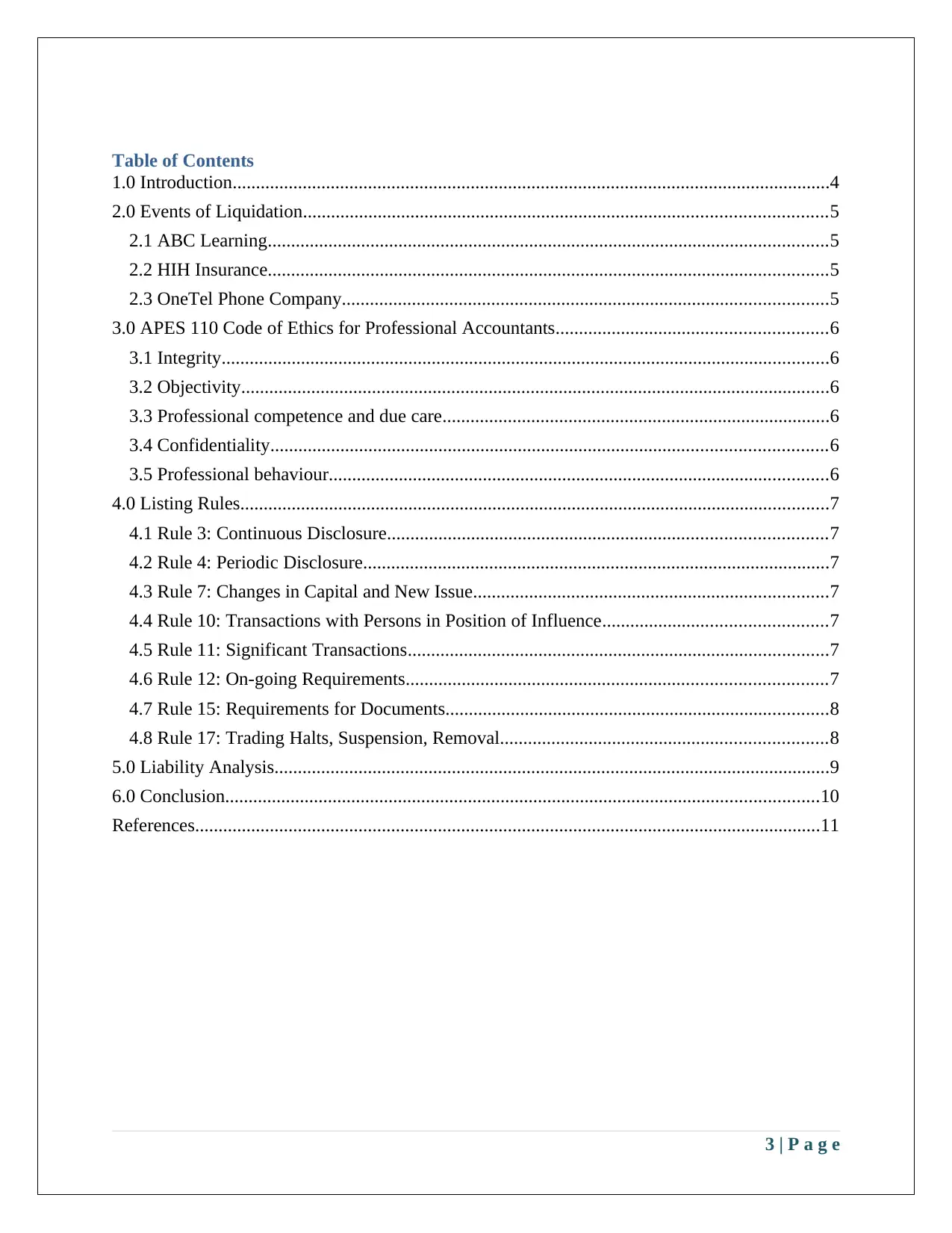
Table of Contents
1.0 Introduction................................................................................................................................4
2.0 Events of Liquidation................................................................................................................5
2.1 ABC Learning........................................................................................................................5
2.2 HIH Insurance........................................................................................................................5
2.3 OneTel Phone Company........................................................................................................5
3.0 APES 110 Code of Ethics for Professional Accountants..........................................................6
3.1 Integrity..................................................................................................................................6
3.2 Objectivity..............................................................................................................................6
3.3 Professional competence and due care...................................................................................6
3.4 Confidentiality.......................................................................................................................6
3.5 Professional behaviour...........................................................................................................6
4.0 Listing Rules..............................................................................................................................7
4.1 Rule 3: Continuous Disclosure..............................................................................................7
4.2 Rule 4: Periodic Disclosure....................................................................................................7
4.3 Rule 7: Changes in Capital and New Issue............................................................................7
4.4 Rule 10: Transactions with Persons in Position of Influence................................................7
4.5 Rule 11: Significant Transactions..........................................................................................7
4.6 Rule 12: On-going Requirements..........................................................................................7
4.7 Rule 15: Requirements for Documents..................................................................................8
4.8 Rule 17: Trading Halts, Suspension, Removal......................................................................8
5.0 Liability Analysis.......................................................................................................................9
6.0 Conclusion...............................................................................................................................10
References......................................................................................................................................11
3 | P a g e
1.0 Introduction................................................................................................................................4
2.0 Events of Liquidation................................................................................................................5
2.1 ABC Learning........................................................................................................................5
2.2 HIH Insurance........................................................................................................................5
2.3 OneTel Phone Company........................................................................................................5
3.0 APES 110 Code of Ethics for Professional Accountants..........................................................6
3.1 Integrity..................................................................................................................................6
3.2 Objectivity..............................................................................................................................6
3.3 Professional competence and due care...................................................................................6
3.4 Confidentiality.......................................................................................................................6
3.5 Professional behaviour...........................................................................................................6
4.0 Listing Rules..............................................................................................................................7
4.1 Rule 3: Continuous Disclosure..............................................................................................7
4.2 Rule 4: Periodic Disclosure....................................................................................................7
4.3 Rule 7: Changes in Capital and New Issue............................................................................7
4.4 Rule 10: Transactions with Persons in Position of Influence................................................7
4.5 Rule 11: Significant Transactions..........................................................................................7
4.6 Rule 12: On-going Requirements..........................................................................................7
4.7 Rule 15: Requirements for Documents..................................................................................8
4.8 Rule 17: Trading Halts, Suspension, Removal......................................................................8
5.0 Liability Analysis.......................................................................................................................9
6.0 Conclusion...............................................................................................................................10
References......................................................................................................................................11
3 | P a g e
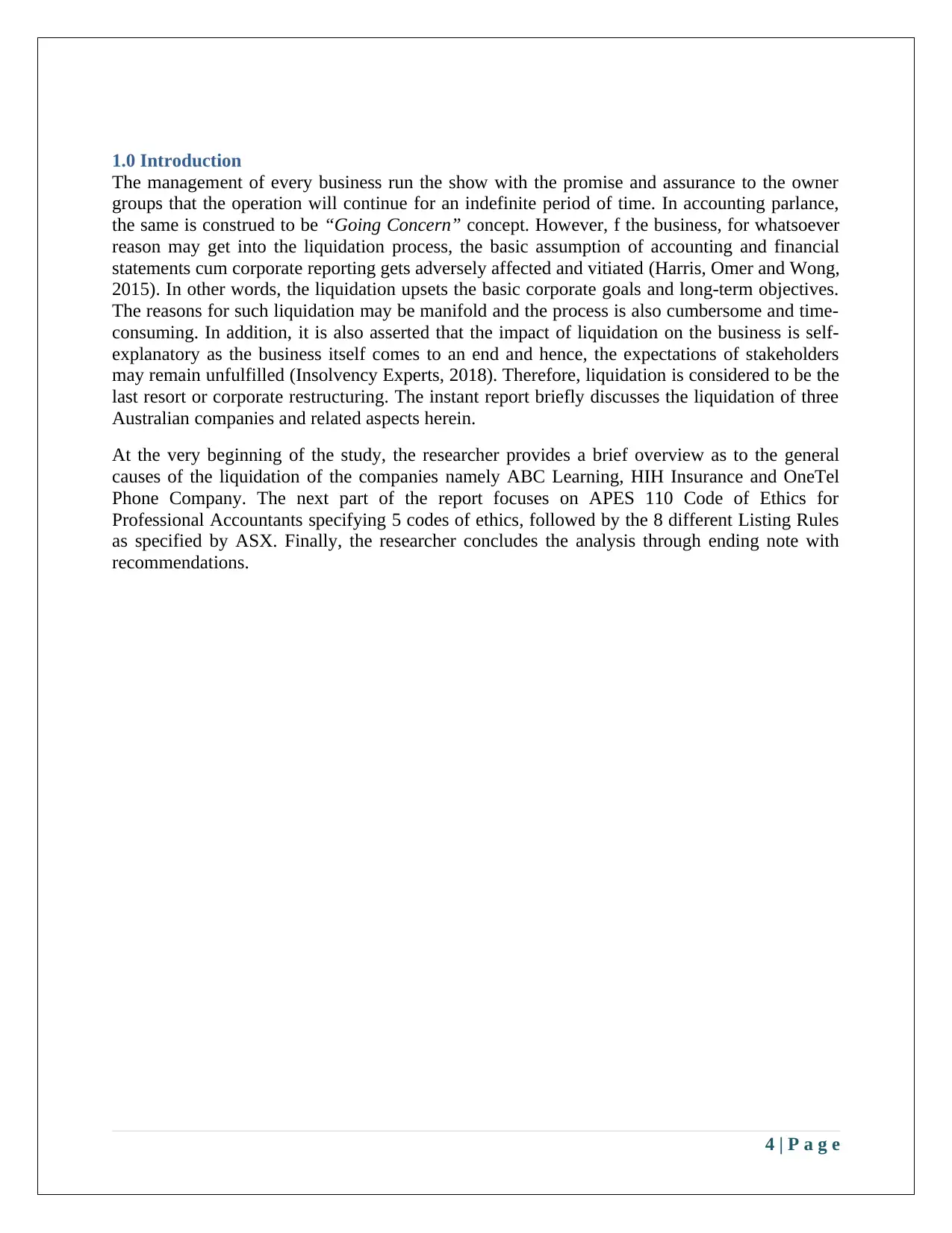
1.0 Introduction
The management of every business run the show with the promise and assurance to the owner
groups that the operation will continue for an indefinite period of time. In accounting parlance,
the same is construed to be “Going Concern” concept. However, f the business, for whatsoever
reason may get into the liquidation process, the basic assumption of accounting and financial
statements cum corporate reporting gets adversely affected and vitiated (Harris, Omer and Wong,
2015). In other words, the liquidation upsets the basic corporate goals and long-term objectives.
The reasons for such liquidation may be manifold and the process is also cumbersome and time-
consuming. In addition, it is also asserted that the impact of liquidation on the business is self-
explanatory as the business itself comes to an end and hence, the expectations of stakeholders
may remain unfulfilled (Insolvency Experts, 2018). Therefore, liquidation is considered to be the
last resort or corporate restructuring. The instant report briefly discusses the liquidation of three
Australian companies and related aspects herein.
At the very beginning of the study, the researcher provides a brief overview as to the general
causes of the liquidation of the companies namely ABC Learning, HIH Insurance and OneTel
Phone Company. The next part of the report focuses on APES 110 Code of Ethics for
Professional Accountants specifying 5 codes of ethics, followed by the 8 different Listing Rules
as specified by ASX. Finally, the researcher concludes the analysis through ending note with
recommendations.
4 | P a g e
The management of every business run the show with the promise and assurance to the owner
groups that the operation will continue for an indefinite period of time. In accounting parlance,
the same is construed to be “Going Concern” concept. However, f the business, for whatsoever
reason may get into the liquidation process, the basic assumption of accounting and financial
statements cum corporate reporting gets adversely affected and vitiated (Harris, Omer and Wong,
2015). In other words, the liquidation upsets the basic corporate goals and long-term objectives.
The reasons for such liquidation may be manifold and the process is also cumbersome and time-
consuming. In addition, it is also asserted that the impact of liquidation on the business is self-
explanatory as the business itself comes to an end and hence, the expectations of stakeholders
may remain unfulfilled (Insolvency Experts, 2018). Therefore, liquidation is considered to be the
last resort or corporate restructuring. The instant report briefly discusses the liquidation of three
Australian companies and related aspects herein.
At the very beginning of the study, the researcher provides a brief overview as to the general
causes of the liquidation of the companies namely ABC Learning, HIH Insurance and OneTel
Phone Company. The next part of the report focuses on APES 110 Code of Ethics for
Professional Accountants specifying 5 codes of ethics, followed by the 8 different Listing Rules
as specified by ASX. Finally, the researcher concludes the analysis through ending note with
recommendations.
4 | P a g e
Secure Best Marks with AI Grader
Need help grading? Try our AI Grader for instant feedback on your assignments.
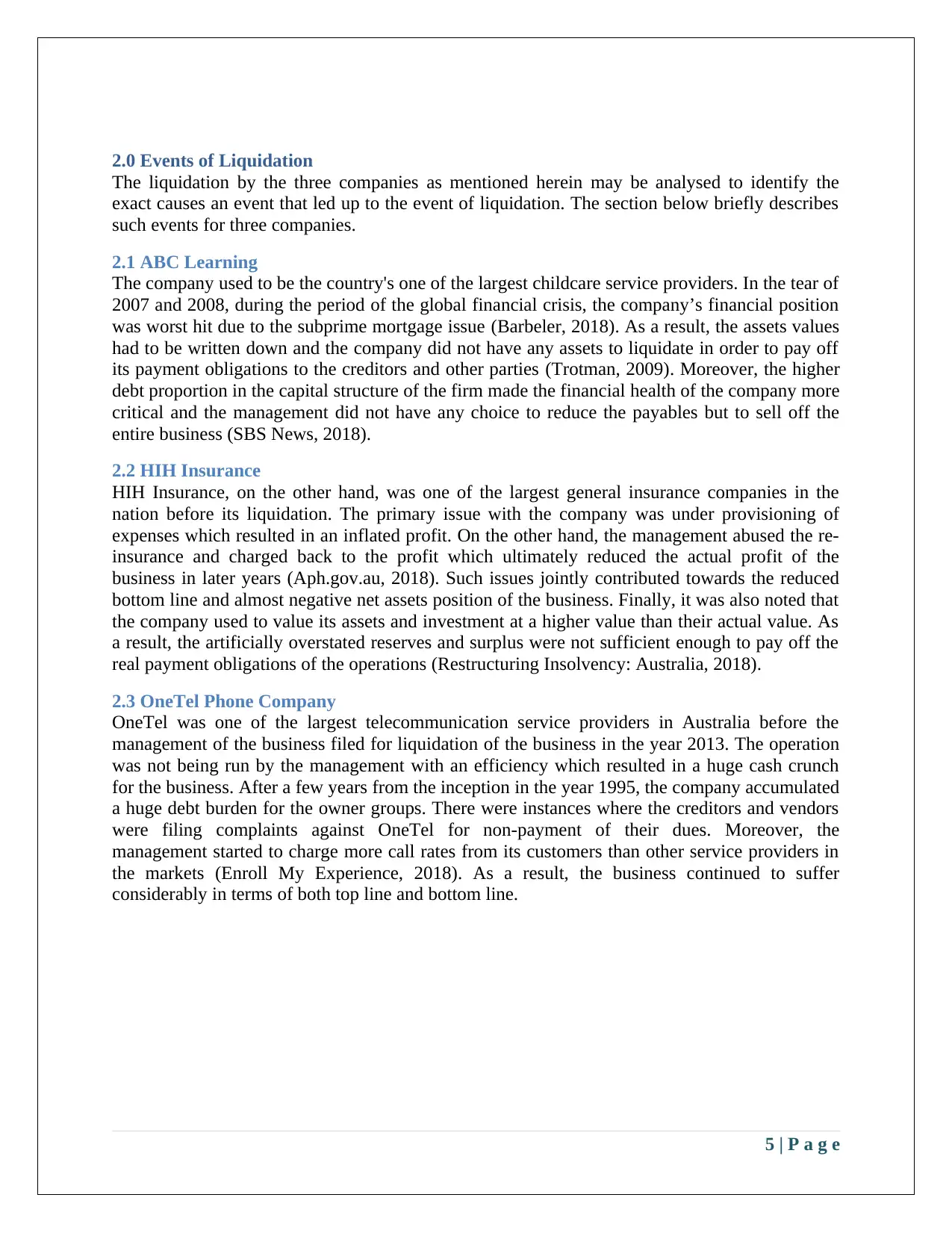
2.0 Events of Liquidation
The liquidation by the three companies as mentioned herein may be analysed to identify the
exact causes an event that led up to the event of liquidation. The section below briefly describes
such events for three companies.
2.1 ABC Learning
The company used to be the country's one of the largest childcare service providers. In the tear of
2007 and 2008, during the period of the global financial crisis, the company’s financial position
was worst hit due to the subprime mortgage issue (Barbeler, 2018). As a result, the assets values
had to be written down and the company did not have any assets to liquidate in order to pay off
its payment obligations to the creditors and other parties (Trotman, 2009). Moreover, the higher
debt proportion in the capital structure of the firm made the financial health of the company more
critical and the management did not have any choice to reduce the payables but to sell off the
entire business (SBS News, 2018).
2.2 HIH Insurance
HIH Insurance, on the other hand, was one of the largest general insurance companies in the
nation before its liquidation. The primary issue with the company was under provisioning of
expenses which resulted in an inflated profit. On the other hand, the management abused the re-
insurance and charged back to the profit which ultimately reduced the actual profit of the
business in later years (Aph.gov.au, 2018). Such issues jointly contributed towards the reduced
bottom line and almost negative net assets position of the business. Finally, it was also noted that
the company used to value its assets and investment at a higher value than their actual value. As
a result, the artificially overstated reserves and surplus were not sufficient enough to pay off the
real payment obligations of the operations (Restructuring Insolvency: Australia, 2018).
2.3 OneTel Phone Company
OneTel was one of the largest telecommunication service providers in Australia before the
management of the business filed for liquidation of the business in the year 2013. The operation
was not being run by the management with an efficiency which resulted in a huge cash crunch
for the business. After a few years from the inception in the year 1995, the company accumulated
a huge debt burden for the owner groups. There were instances where the creditors and vendors
were filing complaints against OneTel for non-payment of their dues. Moreover, the
management started to charge more call rates from its customers than other service providers in
the markets (Enroll My Experience, 2018). As a result, the business continued to suffer
considerably in terms of both top line and bottom line.
5 | P a g e
The liquidation by the three companies as mentioned herein may be analysed to identify the
exact causes an event that led up to the event of liquidation. The section below briefly describes
such events for three companies.
2.1 ABC Learning
The company used to be the country's one of the largest childcare service providers. In the tear of
2007 and 2008, during the period of the global financial crisis, the company’s financial position
was worst hit due to the subprime mortgage issue (Barbeler, 2018). As a result, the assets values
had to be written down and the company did not have any assets to liquidate in order to pay off
its payment obligations to the creditors and other parties (Trotman, 2009). Moreover, the higher
debt proportion in the capital structure of the firm made the financial health of the company more
critical and the management did not have any choice to reduce the payables but to sell off the
entire business (SBS News, 2018).
2.2 HIH Insurance
HIH Insurance, on the other hand, was one of the largest general insurance companies in the
nation before its liquidation. The primary issue with the company was under provisioning of
expenses which resulted in an inflated profit. On the other hand, the management abused the re-
insurance and charged back to the profit which ultimately reduced the actual profit of the
business in later years (Aph.gov.au, 2018). Such issues jointly contributed towards the reduced
bottom line and almost negative net assets position of the business. Finally, it was also noted that
the company used to value its assets and investment at a higher value than their actual value. As
a result, the artificially overstated reserves and surplus were not sufficient enough to pay off the
real payment obligations of the operations (Restructuring Insolvency: Australia, 2018).
2.3 OneTel Phone Company
OneTel was one of the largest telecommunication service providers in Australia before the
management of the business filed for liquidation of the business in the year 2013. The operation
was not being run by the management with an efficiency which resulted in a huge cash crunch
for the business. After a few years from the inception in the year 1995, the company accumulated
a huge debt burden for the owner groups. There were instances where the creditors and vendors
were filing complaints against OneTel for non-payment of their dues. Moreover, the
management started to charge more call rates from its customers than other service providers in
the markets (Enroll My Experience, 2018). As a result, the business continued to suffer
considerably in terms of both top line and bottom line.
5 | P a g e
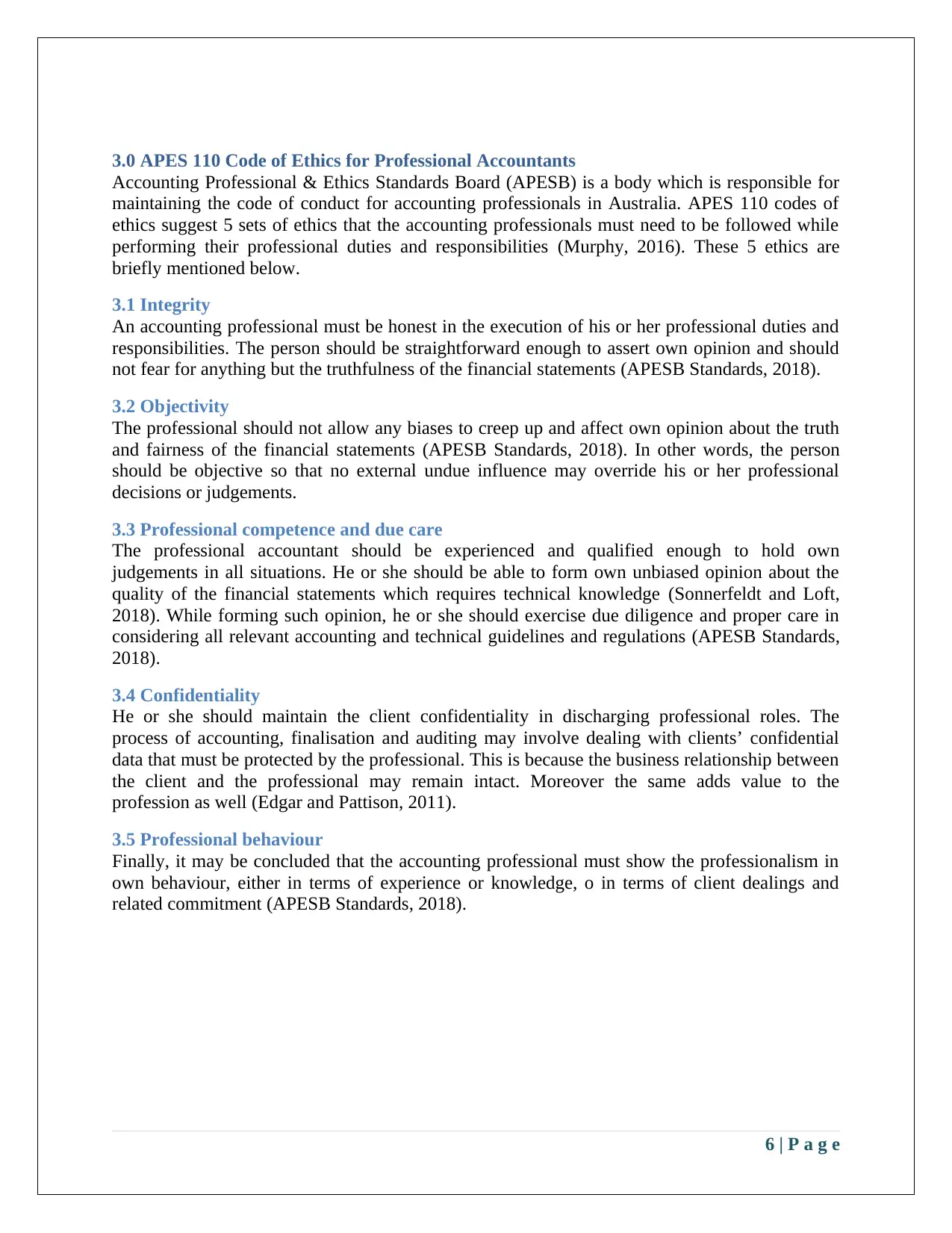
3.0 APES 110 Code of Ethics for Professional Accountants
Accounting Professional & Ethics Standards Board (APESB) is a body which is responsible for
maintaining the code of conduct for accounting professionals in Australia. APES 110 codes of
ethics suggest 5 sets of ethics that the accounting professionals must need to be followed while
performing their professional duties and responsibilities (Murphy, 2016). These 5 ethics are
briefly mentioned below.
3.1 Integrity
An accounting professional must be honest in the execution of his or her professional duties and
responsibilities. The person should be straightforward enough to assert own opinion and should
not fear for anything but the truthfulness of the financial statements (APESB Standards, 2018).
3.2 Objectivity
The professional should not allow any biases to creep up and affect own opinion about the truth
and fairness of the financial statements (APESB Standards, 2018). In other words, the person
should be objective so that no external undue influence may override his or her professional
decisions or judgements.
3.3 Professional competence and due care
The professional accountant should be experienced and qualified enough to hold own
judgements in all situations. He or she should be able to form own unbiased opinion about the
quality of the financial statements which requires technical knowledge (Sonnerfeldt and Loft,
2018). While forming such opinion, he or she should exercise due diligence and proper care in
considering all relevant accounting and technical guidelines and regulations (APESB Standards,
2018).
3.4 Confidentiality
He or she should maintain the client confidentiality in discharging professional roles. The
process of accounting, finalisation and auditing may involve dealing with clients’ confidential
data that must be protected by the professional. This is because the business relationship between
the client and the professional may remain intact. Moreover the same adds value to the
profession as well (Edgar and Pattison, 2011).
3.5 Professional behaviour
Finally, it may be concluded that the accounting professional must show the professionalism in
own behaviour, either in terms of experience or knowledge, o in terms of client dealings and
related commitment (APESB Standards, 2018).
6 | P a g e
Accounting Professional & Ethics Standards Board (APESB) is a body which is responsible for
maintaining the code of conduct for accounting professionals in Australia. APES 110 codes of
ethics suggest 5 sets of ethics that the accounting professionals must need to be followed while
performing their professional duties and responsibilities (Murphy, 2016). These 5 ethics are
briefly mentioned below.
3.1 Integrity
An accounting professional must be honest in the execution of his or her professional duties and
responsibilities. The person should be straightforward enough to assert own opinion and should
not fear for anything but the truthfulness of the financial statements (APESB Standards, 2018).
3.2 Objectivity
The professional should not allow any biases to creep up and affect own opinion about the truth
and fairness of the financial statements (APESB Standards, 2018). In other words, the person
should be objective so that no external undue influence may override his or her professional
decisions or judgements.
3.3 Professional competence and due care
The professional accountant should be experienced and qualified enough to hold own
judgements in all situations. He or she should be able to form own unbiased opinion about the
quality of the financial statements which requires technical knowledge (Sonnerfeldt and Loft,
2018). While forming such opinion, he or she should exercise due diligence and proper care in
considering all relevant accounting and technical guidelines and regulations (APESB Standards,
2018).
3.4 Confidentiality
He or she should maintain the client confidentiality in discharging professional roles. The
process of accounting, finalisation and auditing may involve dealing with clients’ confidential
data that must be protected by the professional. This is because the business relationship between
the client and the professional may remain intact. Moreover the same adds value to the
profession as well (Edgar and Pattison, 2011).
3.5 Professional behaviour
Finally, it may be concluded that the accounting professional must show the professionalism in
own behaviour, either in terms of experience or knowledge, o in terms of client dealings and
related commitment (APESB Standards, 2018).
6 | P a g e
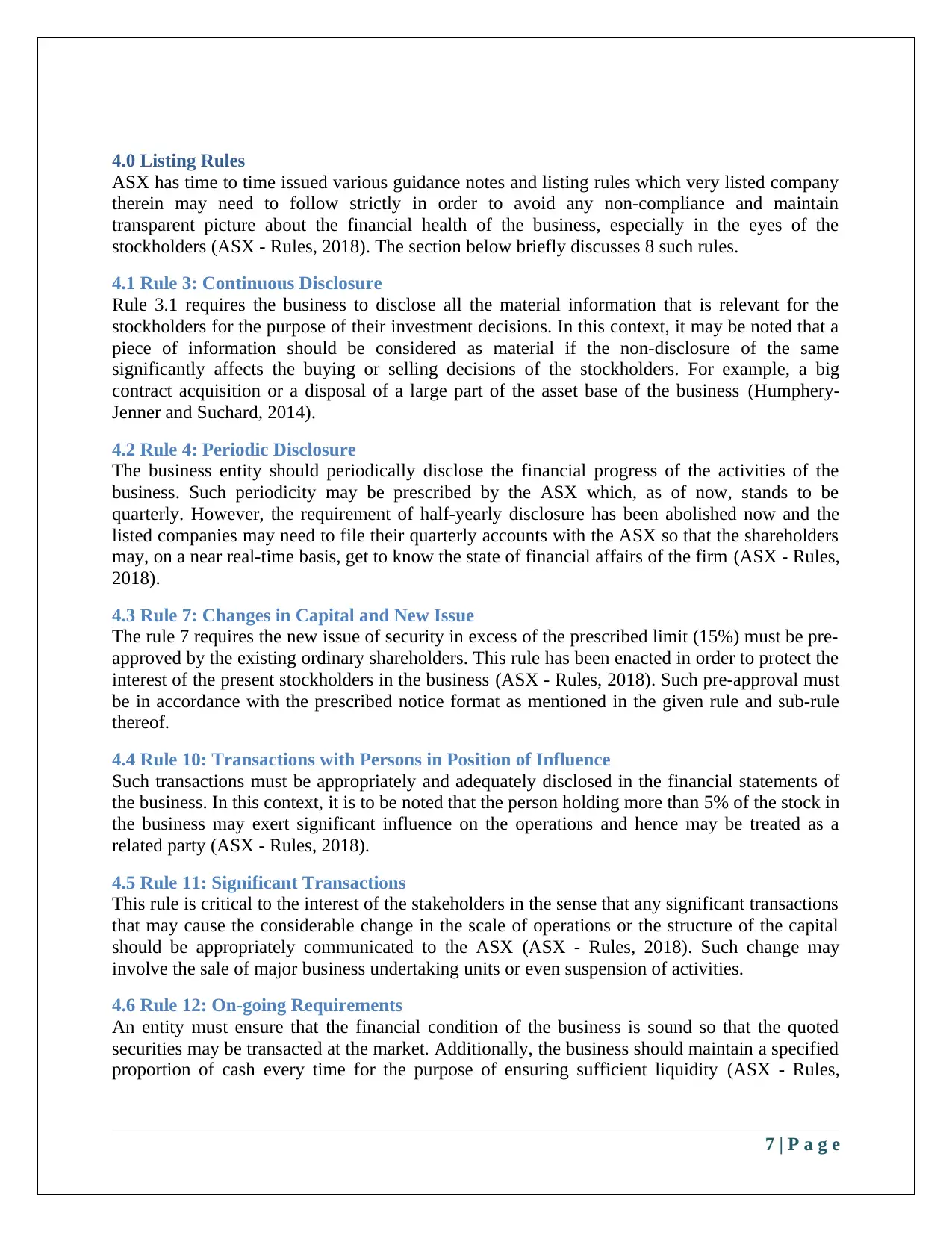
4.0 Listing Rules
ASX has time to time issued various guidance notes and listing rules which very listed company
therein may need to follow strictly in order to avoid any non-compliance and maintain
transparent picture about the financial health of the business, especially in the eyes of the
stockholders (ASX - Rules, 2018). The section below briefly discusses 8 such rules.
4.1 Rule 3: Continuous Disclosure
Rule 3.1 requires the business to disclose all the material information that is relevant for the
stockholders for the purpose of their investment decisions. In this context, it may be noted that a
piece of information should be considered as material if the non-disclosure of the same
significantly affects the buying or selling decisions of the stockholders. For example, a big
contract acquisition or a disposal of a large part of the asset base of the business (Humphery-
Jenner and Suchard, 2014).
4.2 Rule 4: Periodic Disclosure
The business entity should periodically disclose the financial progress of the activities of the
business. Such periodicity may be prescribed by the ASX which, as of now, stands to be
quarterly. However, the requirement of half-yearly disclosure has been abolished now and the
listed companies may need to file their quarterly accounts with the ASX so that the shareholders
may, on a near real-time basis, get to know the state of financial affairs of the firm (ASX - Rules,
2018).
4.3 Rule 7: Changes in Capital and New Issue
The rule 7 requires the new issue of security in excess of the prescribed limit (15%) must be pre-
approved by the existing ordinary shareholders. This rule has been enacted in order to protect the
interest of the present stockholders in the business (ASX - Rules, 2018). Such pre-approval must
be in accordance with the prescribed notice format as mentioned in the given rule and sub-rule
thereof.
4.4 Rule 10: Transactions with Persons in Position of Influence
Such transactions must be appropriately and adequately disclosed in the financial statements of
the business. In this context, it is to be noted that the person holding more than 5% of the stock in
the business may exert significant influence on the operations and hence may be treated as a
related party (ASX - Rules, 2018).
4.5 Rule 11: Significant Transactions
This rule is critical to the interest of the stakeholders in the sense that any significant transactions
that may cause the considerable change in the scale of operations or the structure of the capital
should be appropriately communicated to the ASX (ASX - Rules, 2018). Such change may
involve the sale of major business undertaking units or even suspension of activities.
4.6 Rule 12: On-going Requirements
An entity must ensure that the financial condition of the business is sound so that the quoted
securities may be transacted at the market. Additionally, the business should maintain a specified
proportion of cash every time for the purpose of ensuring sufficient liquidity (ASX - Rules,
7 | P a g e
ASX has time to time issued various guidance notes and listing rules which very listed company
therein may need to follow strictly in order to avoid any non-compliance and maintain
transparent picture about the financial health of the business, especially in the eyes of the
stockholders (ASX - Rules, 2018). The section below briefly discusses 8 such rules.
4.1 Rule 3: Continuous Disclosure
Rule 3.1 requires the business to disclose all the material information that is relevant for the
stockholders for the purpose of their investment decisions. In this context, it may be noted that a
piece of information should be considered as material if the non-disclosure of the same
significantly affects the buying or selling decisions of the stockholders. For example, a big
contract acquisition or a disposal of a large part of the asset base of the business (Humphery-
Jenner and Suchard, 2014).
4.2 Rule 4: Periodic Disclosure
The business entity should periodically disclose the financial progress of the activities of the
business. Such periodicity may be prescribed by the ASX which, as of now, stands to be
quarterly. However, the requirement of half-yearly disclosure has been abolished now and the
listed companies may need to file their quarterly accounts with the ASX so that the shareholders
may, on a near real-time basis, get to know the state of financial affairs of the firm (ASX - Rules,
2018).
4.3 Rule 7: Changes in Capital and New Issue
The rule 7 requires the new issue of security in excess of the prescribed limit (15%) must be pre-
approved by the existing ordinary shareholders. This rule has been enacted in order to protect the
interest of the present stockholders in the business (ASX - Rules, 2018). Such pre-approval must
be in accordance with the prescribed notice format as mentioned in the given rule and sub-rule
thereof.
4.4 Rule 10: Transactions with Persons in Position of Influence
Such transactions must be appropriately and adequately disclosed in the financial statements of
the business. In this context, it is to be noted that the person holding more than 5% of the stock in
the business may exert significant influence on the operations and hence may be treated as a
related party (ASX - Rules, 2018).
4.5 Rule 11: Significant Transactions
This rule is critical to the interest of the stakeholders in the sense that any significant transactions
that may cause the considerable change in the scale of operations or the structure of the capital
should be appropriately communicated to the ASX (ASX - Rules, 2018). Such change may
involve the sale of major business undertaking units or even suspension of activities.
4.6 Rule 12: On-going Requirements
An entity must ensure that the financial condition of the business is sound so that the quoted
securities may be transacted at the market. Additionally, the business should maintain a specified
proportion of cash every time for the purpose of ensuring sufficient liquidity (ASX - Rules,
7 | P a g e
Paraphrase This Document
Need a fresh take? Get an instant paraphrase of this document with our AI Paraphraser
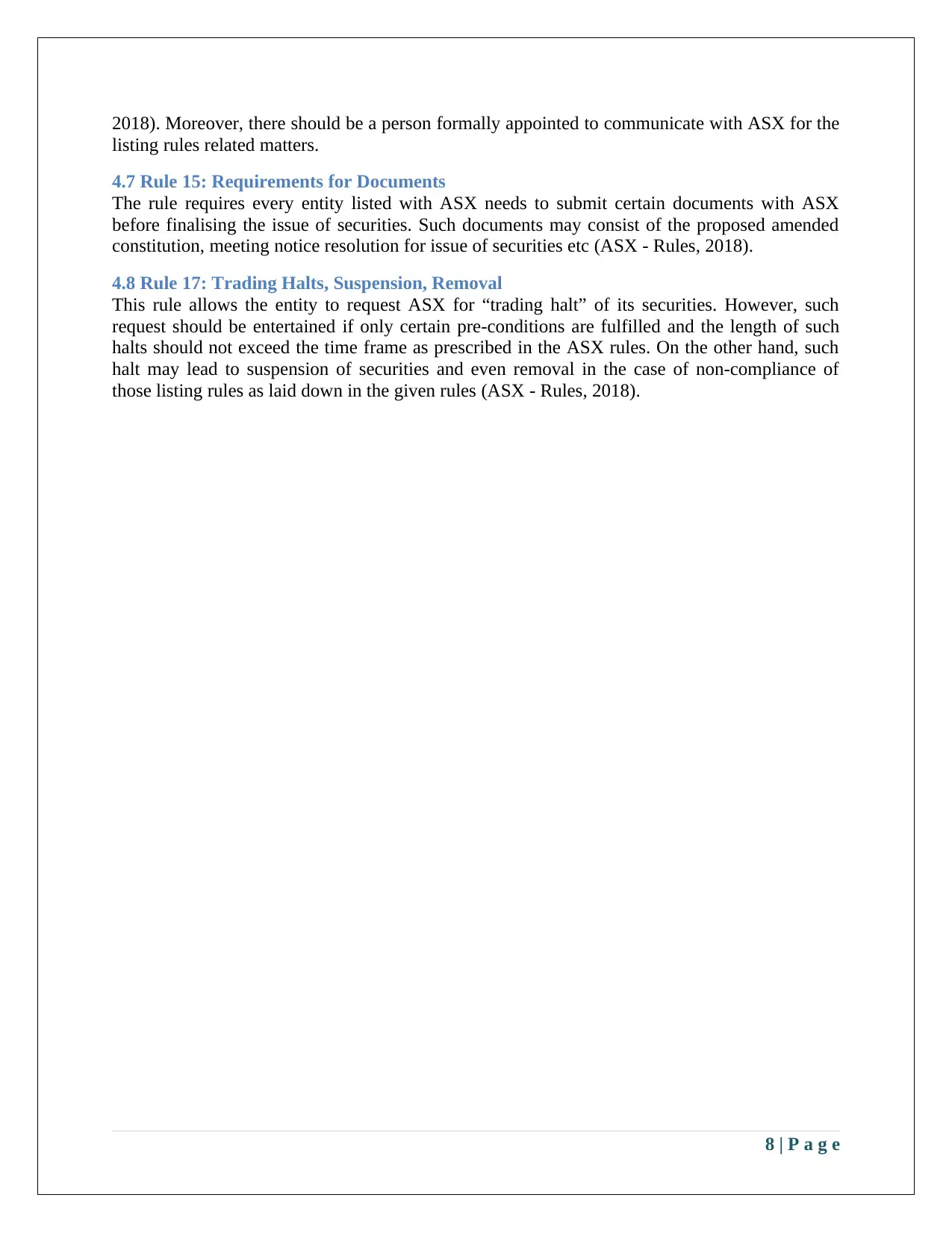
2018). Moreover, there should be a person formally appointed to communicate with ASX for the
listing rules related matters.
4.7 Rule 15: Requirements for Documents
The rule requires every entity listed with ASX needs to submit certain documents with ASX
before finalising the issue of securities. Such documents may consist of the proposed amended
constitution, meeting notice resolution for issue of securities etc (ASX - Rules, 2018).
4.8 Rule 17: Trading Halts, Suspension, Removal
This rule allows the entity to request ASX for “trading halt” of its securities. However, such
request should be entertained if only certain pre-conditions are fulfilled and the length of such
halts should not exceed the time frame as prescribed in the ASX rules. On the other hand, such
halt may lead to suspension of securities and even removal in the case of non-compliance of
those listing rules as laid down in the given rules (ASX - Rules, 2018).
8 | P a g e
listing rules related matters.
4.7 Rule 15: Requirements for Documents
The rule requires every entity listed with ASX needs to submit certain documents with ASX
before finalising the issue of securities. Such documents may consist of the proposed amended
constitution, meeting notice resolution for issue of securities etc (ASX - Rules, 2018).
4.8 Rule 17: Trading Halts, Suspension, Removal
This rule allows the entity to request ASX for “trading halt” of its securities. However, such
request should be entertained if only certain pre-conditions are fulfilled and the length of such
halts should not exceed the time frame as prescribed in the ASX rules. On the other hand, such
halt may lead to suspension of securities and even removal in the case of non-compliance of
those listing rules as laid down in the given rules (ASX - Rules, 2018).
8 | P a g e
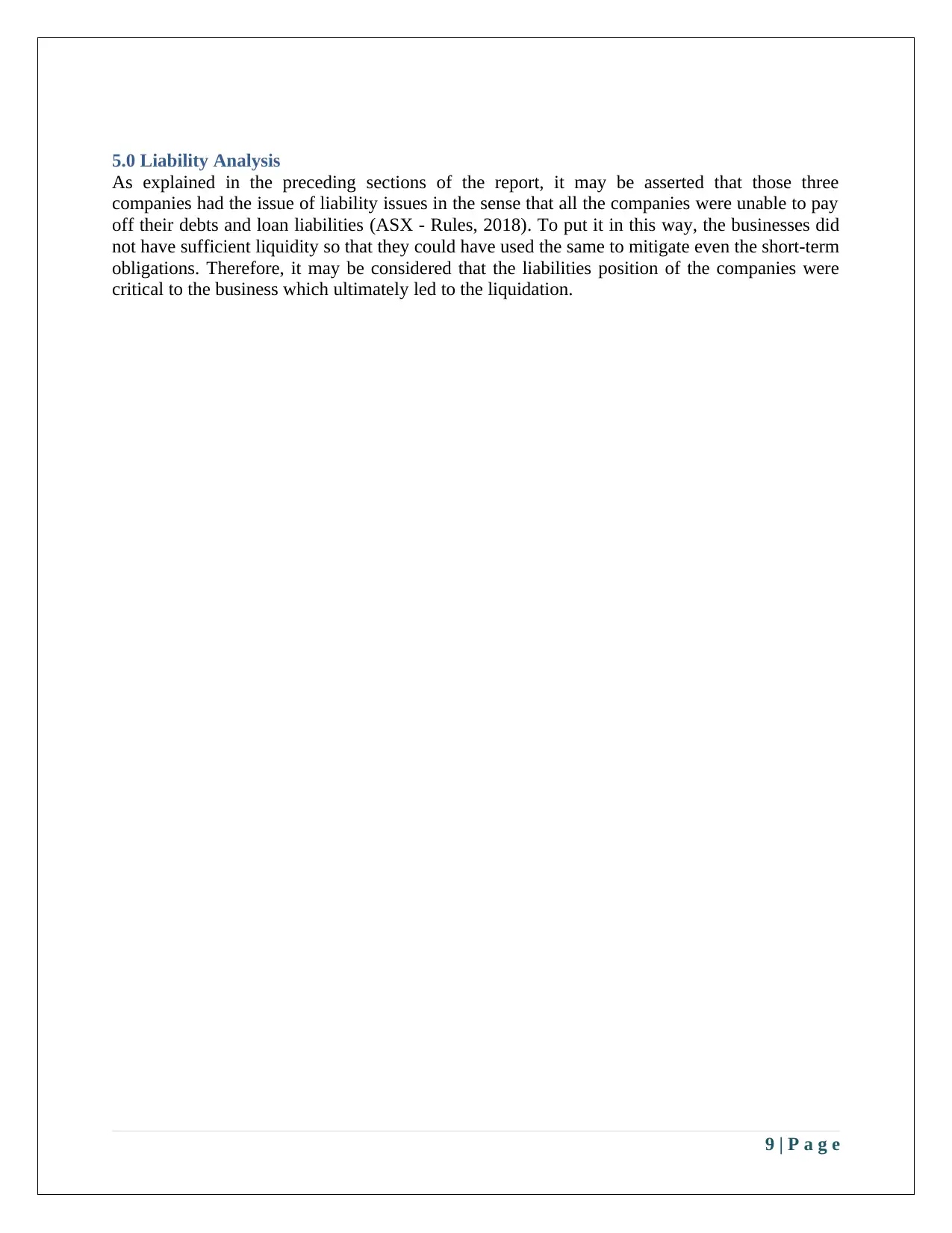
5.0 Liability Analysis
As explained in the preceding sections of the report, it may be asserted that those three
companies had the issue of liability issues in the sense that all the companies were unable to pay
off their debts and loan liabilities (ASX - Rules, 2018). To put it in this way, the businesses did
not have sufficient liquidity so that they could have used the same to mitigate even the short-term
obligations. Therefore, it may be considered that the liabilities position of the companies were
critical to the business which ultimately led to the liquidation.
9 | P a g e
As explained in the preceding sections of the report, it may be asserted that those three
companies had the issue of liability issues in the sense that all the companies were unable to pay
off their debts and loan liabilities (ASX - Rules, 2018). To put it in this way, the businesses did
not have sufficient liquidity so that they could have used the same to mitigate even the short-term
obligations. Therefore, it may be considered that the liabilities position of the companies were
critical to the business which ultimately led to the liquidation.
9 | P a g e
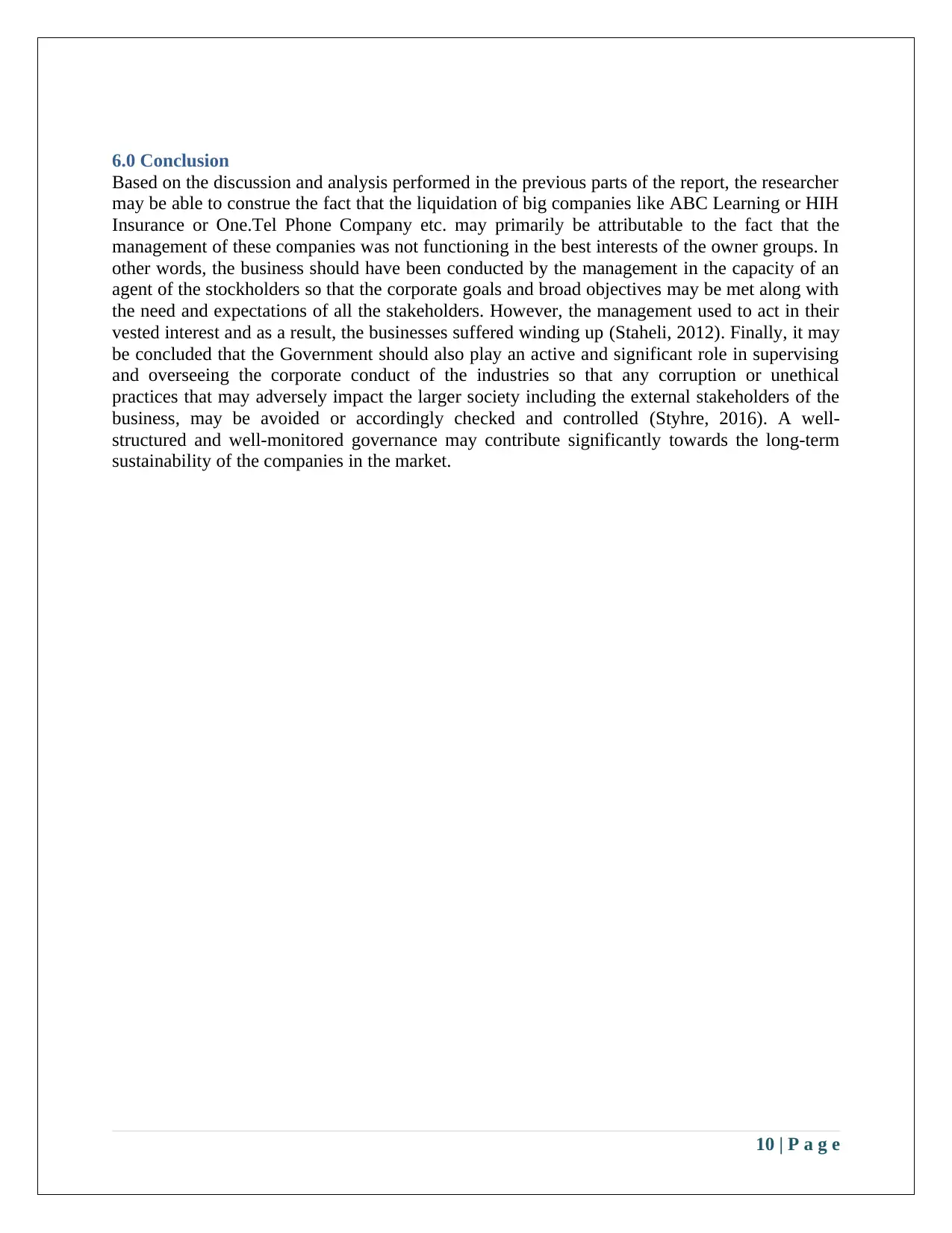
6.0 Conclusion
Based on the discussion and analysis performed in the previous parts of the report, the researcher
may be able to construe the fact that the liquidation of big companies like ABC Learning or HIH
Insurance or One.Tel Phone Company etc. may primarily be attributable to the fact that the
management of these companies was not functioning in the best interests of the owner groups. In
other words, the business should have been conducted by the management in the capacity of an
agent of the stockholders so that the corporate goals and broad objectives may be met along with
the need and expectations of all the stakeholders. However, the management used to act in their
vested interest and as a result, the businesses suffered winding up (Staheli, 2012). Finally, it may
be concluded that the Government should also play an active and significant role in supervising
and overseeing the corporate conduct of the industries so that any corruption or unethical
practices that may adversely impact the larger society including the external stakeholders of the
business, may be avoided or accordingly checked and controlled (Styhre, 2016). A well-
structured and well-monitored governance may contribute significantly towards the long-term
sustainability of the companies in the market.
10 | P a g e
Based on the discussion and analysis performed in the previous parts of the report, the researcher
may be able to construe the fact that the liquidation of big companies like ABC Learning or HIH
Insurance or One.Tel Phone Company etc. may primarily be attributable to the fact that the
management of these companies was not functioning in the best interests of the owner groups. In
other words, the business should have been conducted by the management in the capacity of an
agent of the stockholders so that the corporate goals and broad objectives may be met along with
the need and expectations of all the stakeholders. However, the management used to act in their
vested interest and as a result, the businesses suffered winding up (Staheli, 2012). Finally, it may
be concluded that the Government should also play an active and significant role in supervising
and overseeing the corporate conduct of the industries so that any corruption or unethical
practices that may adversely impact the larger society including the external stakeholders of the
business, may be avoided or accordingly checked and controlled (Styhre, 2016). A well-
structured and well-monitored governance may contribute significantly towards the long-term
sustainability of the companies in the market.
10 | P a g e
Secure Best Marks with AI Grader
Need help grading? Try our AI Grader for instant feedback on your assignments.
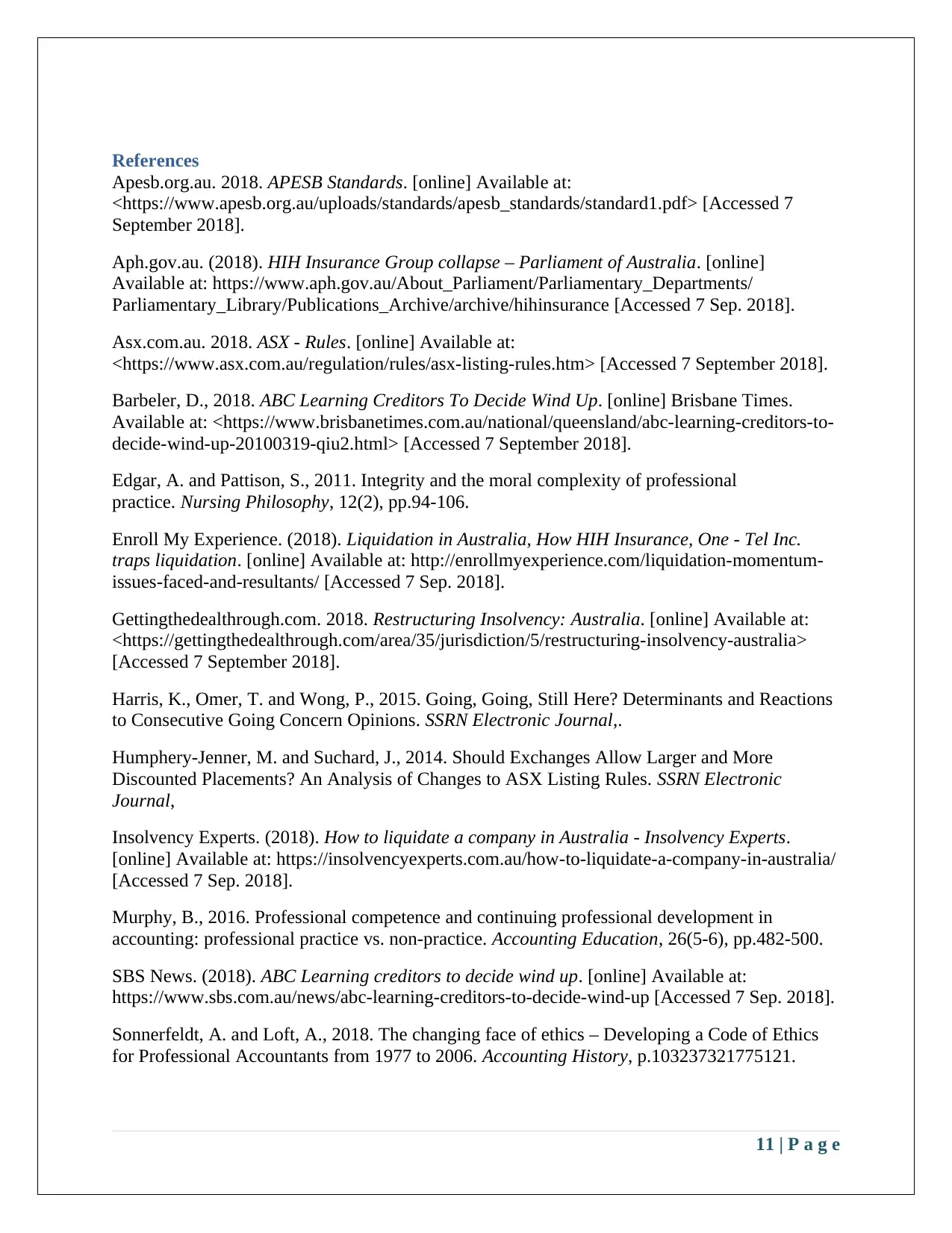
References
Apesb.org.au. 2018. APESB Standards. [online] Available at:
<https://www.apesb.org.au/uploads/standards/apesb_standards/standard1.pdf> [Accessed 7
September 2018].
Aph.gov.au. (2018). HIH Insurance Group collapse – Parliament of Australia. [online]
Available at: https://www.aph.gov.au/About_Parliament/Parliamentary_Departments/
Parliamentary_Library/Publications_Archive/archive/hihinsurance [Accessed 7 Sep. 2018].
Asx.com.au. 2018. ASX - Rules. [online] Available at:
<https://www.asx.com.au/regulation/rules/asx-listing-rules.htm> [Accessed 7 September 2018].
Barbeler, D., 2018. ABC Learning Creditors To Decide Wind Up. [online] Brisbane Times.
Available at: <https://www.brisbanetimes.com.au/national/queensland/abc-learning-creditors-to-
decide-wind-up-20100319-qiu2.html> [Accessed 7 September 2018].
Edgar, A. and Pattison, S., 2011. Integrity and the moral complexity of professional
practice. Nursing Philosophy, 12(2), pp.94-106.
Enroll My Experience. (2018). Liquidation in Australia, How HIH Insurance, One - Tel Inc.
traps liquidation. [online] Available at: http://enrollmyexperience.com/liquidation-momentum-
issues-faced-and-resultants/ [Accessed 7 Sep. 2018].
Gettingthedealthrough.com. 2018. Restructuring Insolvency: Australia. [online] Available at:
<https://gettingthedealthrough.com/area/35/jurisdiction/5/restructuring-insolvency-australia>
[Accessed 7 September 2018].
Harris, K., Omer, T. and Wong, P., 2015. Going, Going, Still Here? Determinants and Reactions
to Consecutive Going Concern Opinions. SSRN Electronic Journal,.
Humphery-Jenner, M. and Suchard, J., 2014. Should Exchanges Allow Larger and More
Discounted Placements? An Analysis of Changes to ASX Listing Rules. SSRN Electronic
Journal,
Insolvency Experts. (2018). How to liquidate a company in Australia - Insolvency Experts.
[online] Available at: https://insolvencyexperts.com.au/how-to-liquidate-a-company-in-australia/
[Accessed 7 Sep. 2018].
Murphy, B., 2016. Professional competence and continuing professional development in
accounting: professional practice vs. non-practice. Accounting Education, 26(5-6), pp.482-500.
SBS News. (2018). ABC Learning creditors to decide wind up. [online] Available at:
https://www.sbs.com.au/news/abc-learning-creditors-to-decide-wind-up [Accessed 7 Sep. 2018].
Sonnerfeldt, A. and Loft, A., 2018. The changing face of ethics – Developing a Code of Ethics
for Professional Accountants from 1977 to 2006. Accounting History, p.103237321775121.
11 | P a g e
Apesb.org.au. 2018. APESB Standards. [online] Available at:
<https://www.apesb.org.au/uploads/standards/apesb_standards/standard1.pdf> [Accessed 7
September 2018].
Aph.gov.au. (2018). HIH Insurance Group collapse – Parliament of Australia. [online]
Available at: https://www.aph.gov.au/About_Parliament/Parliamentary_Departments/
Parliamentary_Library/Publications_Archive/archive/hihinsurance [Accessed 7 Sep. 2018].
Asx.com.au. 2018. ASX - Rules. [online] Available at:
<https://www.asx.com.au/regulation/rules/asx-listing-rules.htm> [Accessed 7 September 2018].
Barbeler, D., 2018. ABC Learning Creditors To Decide Wind Up. [online] Brisbane Times.
Available at: <https://www.brisbanetimes.com.au/national/queensland/abc-learning-creditors-to-
decide-wind-up-20100319-qiu2.html> [Accessed 7 September 2018].
Edgar, A. and Pattison, S., 2011. Integrity and the moral complexity of professional
practice. Nursing Philosophy, 12(2), pp.94-106.
Enroll My Experience. (2018). Liquidation in Australia, How HIH Insurance, One - Tel Inc.
traps liquidation. [online] Available at: http://enrollmyexperience.com/liquidation-momentum-
issues-faced-and-resultants/ [Accessed 7 Sep. 2018].
Gettingthedealthrough.com. 2018. Restructuring Insolvency: Australia. [online] Available at:
<https://gettingthedealthrough.com/area/35/jurisdiction/5/restructuring-insolvency-australia>
[Accessed 7 September 2018].
Harris, K., Omer, T. and Wong, P., 2015. Going, Going, Still Here? Determinants and Reactions
to Consecutive Going Concern Opinions. SSRN Electronic Journal,.
Humphery-Jenner, M. and Suchard, J., 2014. Should Exchanges Allow Larger and More
Discounted Placements? An Analysis of Changes to ASX Listing Rules. SSRN Electronic
Journal,
Insolvency Experts. (2018). How to liquidate a company in Australia - Insolvency Experts.
[online] Available at: https://insolvencyexperts.com.au/how-to-liquidate-a-company-in-australia/
[Accessed 7 Sep. 2018].
Murphy, B., 2016. Professional competence and continuing professional development in
accounting: professional practice vs. non-practice. Accounting Education, 26(5-6), pp.482-500.
SBS News. (2018). ABC Learning creditors to decide wind up. [online] Available at:
https://www.sbs.com.au/news/abc-learning-creditors-to-decide-wind-up [Accessed 7 Sep. 2018].
Sonnerfeldt, A. and Loft, A., 2018. The changing face of ethics – Developing a Code of Ethics
for Professional Accountants from 1977 to 2006. Accounting History, p.103237321775121.
11 | P a g e
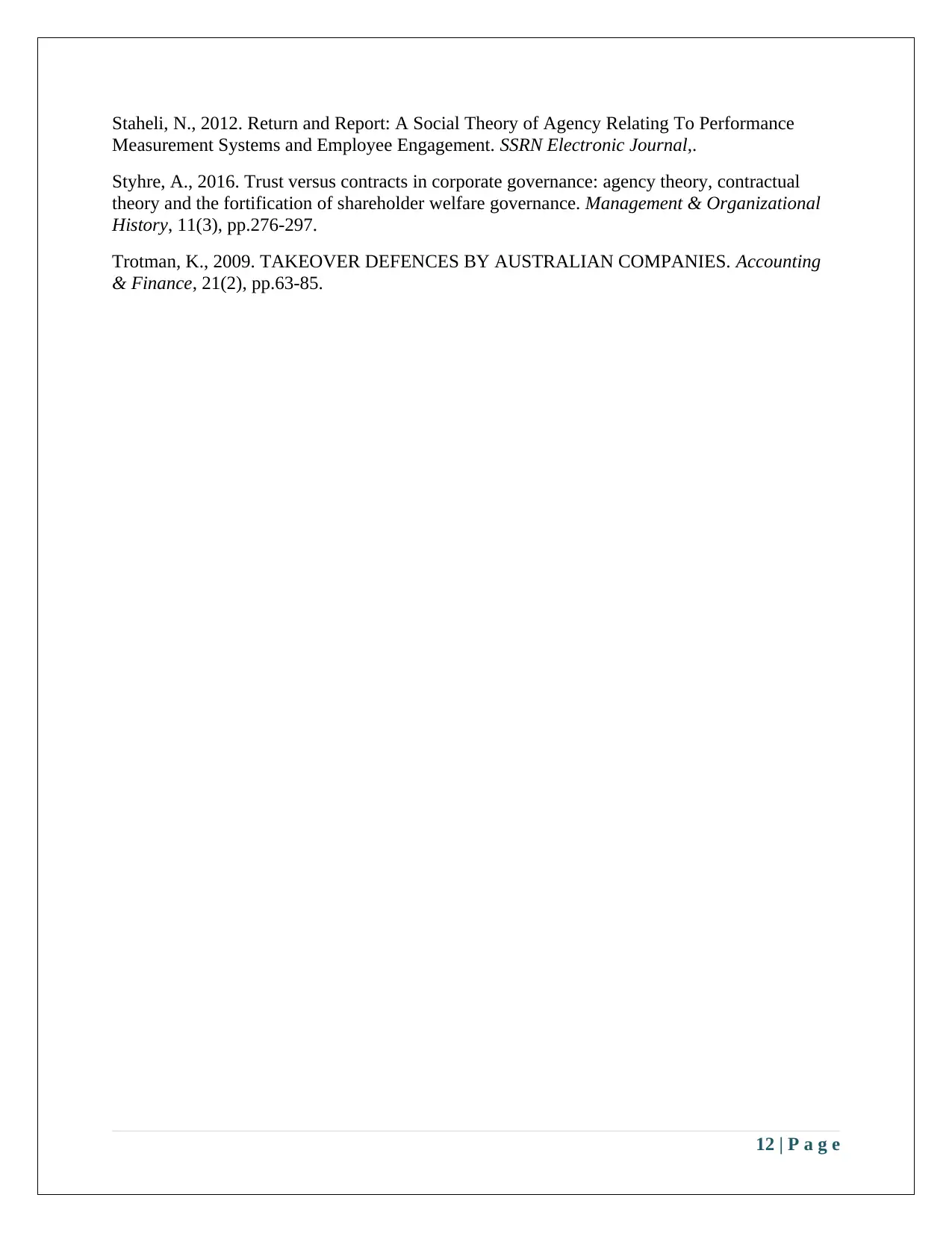
Staheli, N., 2012. Return and Report: A Social Theory of Agency Relating To Performance
Measurement Systems and Employee Engagement. SSRN Electronic Journal,.
Styhre, A., 2016. Trust versus contracts in corporate governance: agency theory, contractual
theory and the fortification of shareholder welfare governance. Management & Organizational
History, 11(3), pp.276-297.
Trotman, K., 2009. TAKEOVER DEFENCES BY AUSTRALIAN COMPANIES. Accounting
& Finance, 21(2), pp.63-85.
12 | P a g e
Measurement Systems and Employee Engagement. SSRN Electronic Journal,.
Styhre, A., 2016. Trust versus contracts in corporate governance: agency theory, contractual
theory and the fortification of shareholder welfare governance. Management & Organizational
History, 11(3), pp.276-297.
Trotman, K., 2009. TAKEOVER DEFENCES BY AUSTRALIAN COMPANIES. Accounting
& Finance, 21(2), pp.63-85.
12 | P a g e
1 out of 12
Related Documents
Your All-in-One AI-Powered Toolkit for Academic Success.
+13062052269
info@desklib.com
Available 24*7 on WhatsApp / Email
![[object Object]](/_next/static/media/star-bottom.7253800d.svg)
Unlock your academic potential
© 2024 | Zucol Services PVT LTD | All rights reserved.





